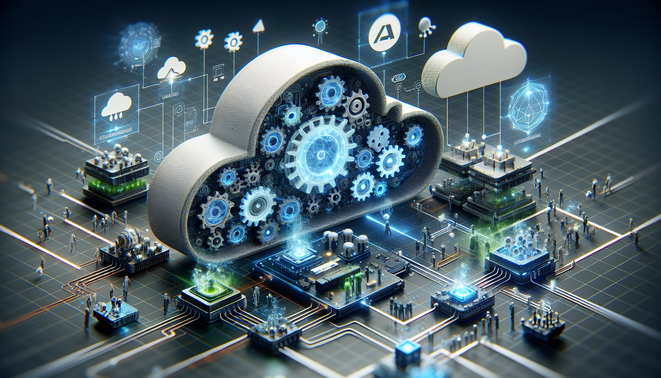Physical Address
304 North Cardinal St.
Dorchester Center, MA 02124
Physical Address
304 North Cardinal St.
Dorchester Center, MA 02124

Autonomous AI Workflow Agents in Cloud Computing
Autonomous AI workflow agents are transforming business operations by automating complex tasks and enhancing decision-making in cloud environments. This article delves into their architecture, integration with cloud APIs, and best practices for implementation, emphasizing efficiency and adaptability.
Meta Summary
Explore the transformative impact of autonomous AI workflow agents in cloud computing, highlighting their architecture, integration techniques, and implementation best practices to optimize business processes.
Introduction to Autonomous AI Workflow Agents
Autonomous AI agents are reshaping the landscape of cloud computing. These software entities execute tasks and make decisions independently using data-driven insights, mimicking human decision-making without needing constant oversight.
Learning Objectives
Understand the purpose of autonomous AI agents in business efficiency and accuracy.
Identify key features and capabilities, including task automation, decision-making, scalability, and adaptability.
Autonomous AI agents function seamlessly within modern cloud ecosystems, harnessing data resources and computational power for efficient task execution. They automate workflows and provide insights to propel business strategies.
Core Architecture of AI Agents in Cloud Environments
A robust architecture is critical for the efficiency and scalability of AI agents in cloud environments. It supports massive data processing, seamless integration with services, and adaptability to business changes.
Learning Objectives
Describe the architectural components of AI agents: This includes data ingestion, processing engines, algorithms, and communication interfaces.
Explain the role of microservices in enhancing scalability: Microservices allow independent operations, efficient scaling, and modular updates.
The architecture typically consists of interconnected microservices for data processing, user interaction, and communication, enabling hassle-free component updates.
Integrating AI Agents with Cloud APIs
Integration with cloud APIs is pivotal for AI agents to access external data and functionalities, expanding their capabilities.
Learning Objectives
Demonstrate the integration process with cloud APIs: Establishing secure and efficient connections is crucial.
Identify best practices for API management and security, including encryption and security audits.
Successfully integrating APIs involves secure setup, robust authentication, and data integrity assurance. This ensures agent reliability through strong encryption and error handling.
Implementing Feedback Loops for Continuous Improvement
Feedback loops are essential to refine AI workflows, enhancing accuracy and efficiency over time through iterative learning.
Learning Objectives
Explain the importance of feedback loops in AI: They allow process refinement by learning from past actions.
Identify effective feedback collection methods, including performance monitoring and data analytics.
Feedback loops collect performance data to identify and correct discrepancies, improving algorithms for sustained relevance and accuracy.
Utilizing Retrieval-Augmented Generation (RAG)
RAG enhances AI performance by merging information retrieval with text generation, boosting response contextuality and accuracy.
Learning Objectives
Understand RAG principles to enhance AI success: This technique combines data retrieval with generation for enriched outputs.
Integrate RAG techniques into workflows, selecting relevant data sources and optimizing algorithms.
RAG is beneficial for delivering detailed responses and informed decisions, leveraging extensive datasets for nuanced solutions.
Decision Automation Techniques
Decision automation in cloud environments accelerates workflow execution, optimizing resource management and scalability.
Learning Objectives
Define and recognize decision automation’s role in cloud computing: Enhancing operational efficiency with reduced human intervention.
Discover tools aiding decision automation, such as machine learning models and rule-based systems.
These tools identify patterns, predict outcomes, and autonomously make decisions to streamline operations.
Case Studies of Successful Implementations
Real-world case studies reveal the application and effectiveness of autonomous AI agents in diverse industries.
Learning Objectives
Analyze applications and impacts of AI agents: Exploring versatility in different sectors.
Extract lessons from successful implementations, analyzing key success factors and challenges.
For example, a tech company’s AI agents cut deployment time by 50%, showcasing AI’s potential to optimize processes significantly.
Best Practices and Common Pitfalls
Best practices and awareness of common pitfalls are vital for successful AI agent deployment.
Best Practices
Error handling in APIs: Ensures agent reliability with comprehensive handling to prevent disruptions.
Regular AI model updates: Maintain accuracy and relevance with continual improvements.
Containerization for deployment: Ensures consistent environments and simplifies maintenance.
Common Pitfalls
Neglecting post-deployment performance monitoring: Continuous oversight identifies issues and optimizes performance.
Overly complex architectures: Simplifying systems aids in maintenance and scalability.
Overlooking security in API integration: Strong security measures protect data integrity.
Visual Aids Suggestions
To aid understanding, consider creating:
An architecture diagram showing AI agent interactions with cloud services.
Flowcharts illustrating data processing and decision-making pathways.
Key Takeaways
Autonomous AI agents revolutionize cloud computing by automating workflows and decision-making.
Understanding core architecture and cloud API integration is crucial for success.
Feedback loops and RAG techniques boost AI performance.
Decision automation enhances efficiency and resource management.
Learning from case studies fosters improved deployment and operation success.
Glossary
Autonomous AI Agents: Software that independently performs tasks and makes decisions.
Cloud API: Interfaces for programmatically accessing cloud service features.
Retrieval-Augmented Generation (RAG): Combines data retrieval with text generation for better AI performance.
Feedback Loop: A system where outputs are fed back as inputs for improvement.
Decision Automation: Automating decision-making processes using technology.
Knowledge Check
What defines an autonomous AI agent?
A. A type of cloud service
B. A software entity that performs tasks independently
C. A data storage solution
How can feedback loops enhance AI performance?
What are key challenges in API integration security?
Further Reading
Autonomous AI Workflow Agents
Cloud Integration Strategies
Retrieval-Augmented Generation